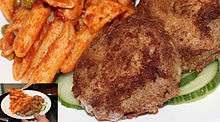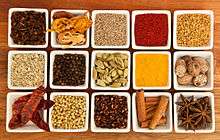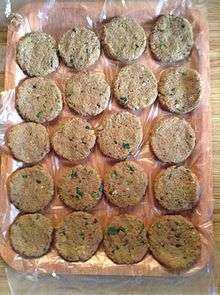Shami kebab
 Shami kebab on a bed of cucumbers, served with pasta | |
| Place of origin | Medieval India |
|---|---|
| Region or state | Indian subcontinent |
| Main ingredients | Meat, fish and spices |
| Variations | Many variations exist |
| Vary kcal | |
|
| |
 |
| This article is part of the series |
| Indian cuisine |
|---|
|
Regional cuisines
|
|
Ingredients, types of food |
|
See also
|
|
Shami kabab or Shaami kabab (Urdu: شامی کباب, Hindi: शामी कबाब) is a local variety of kebab from the Indian subcontinent. It is part of the Indian, Pakistani and Bangladeshi cuisines.[1] It is composed of a small patty of minced or ground meat (usually potato or paneer in India, but occasionally beef, lamb or mutton as well), with ground chickpeas, egg to hold it together, and spices.[2][3] Shami kebab is eaten as a snack or an appetizer. Shami Kebab is served to guests especially in the regions of Hyderabad Deccan, Punjab, Kashmir, Uttar Pradesh and Sindh.
Shami kebabs are a popular snack throughout Bangladesh, India and Pakistan.[4][5] They are often garnished with lemon juice and served with sliced raw onions as a side salad, and may be eaten with chutney made from mint or coriander.[6] They are also served along with sheer khurma during Eid celebrations.
 |
| This article is part of the series |
| Pakistani cuisine پاکستانی پکوان |
|---|
|
See also
|
|
Preparation

Shami kababs are boiled or sauteed meat (mutton or chicken) and chickpeas (chana daal) with whole hot spices (garam masala, black pepper, cinnamon, cloves, bay leaves), whole ginger, whole garlic and some salt to taste until completely tender. Onions, turmeric, chili powder, egg, chopped green coriander, chopped green chillies and chopped mint leaves may be added in preparing kebab. Garam masala powder (ground spices) may be used in place of whole hot spices.[7][8][9]
The cooked meat is then ground in such a way that is fibrous and does not become a paste. It is then shaped into diamond or round patties and is shallow fried.
Serving
Shami kebabs may be served with roti along with ketchup, hot sauce, chilli garlic sauce, raita or chutney. Before serving the kebabs, it is also common to dip them in a beaten egg mixture and double fry them. They are also commonly eaten in Hyderabad with ordinary rice or chapati.
Etymology
The popular etymology in Pakistan is that the name Shami Kebab may refer to Bilad al-Sham, the modern Syria, as many cooks from that region migrated to the wealthy Mughal Empire during the Middle Ages.[10] While the popular etymology in India is that the name refer to word Shaam which means evening in Urdu and Hindi languages.[11]
See also
- Hyderabadi cuisine
- Punjabi cuisine
- Sindhi cuisine
- Indian cuisine
- List of kebabs
- Pakistani cuisine
- Pakistani meat dishes
- Bengali cuisine
-
 Food portal
Food portal -
 India portal
India portal -
 Pakistan portal
Pakistan portal
References
- ↑ "Shami Kabab". fauziaskitchenfun.com.
- ↑ "Shami Kebab Recipe". indianfoodforever.com.
- ↑ http://www.faskitchen.com/how-to-make-shami-kabab-recipe/
- ↑ Mamta Gupta. "Shami Kabab, Meat or Chicken". mamtaskitchen.com. Mamta Gupta and F2 Limited.
- ↑ "Spring Shami Kabab". zabihabites.com. Zabiha Bites. 12 May 2013.
- ↑ "Sami Kebabs". BBC.
- ↑ "Shami Kabab Recipe". www.angelfire.com/country/fauziaspakistan. fauziaspakistan.
- ↑ Petrina Verma Sarkar (10 December 2014). "Shami Kabab". About.com. About.com.
- ↑ "Chicken Shami Kebab". fortheloveofyum.wordpress.com. 1 April 2015.
- ↑ Chef Honey Dukes (5 December 2013). "The "traditional" Shami Kabab". dathreebroomsticks.com.
- ↑ "Shami Kebab". khadizaskitchen.com. 23 November 2014.
External links
- Indian Curry: Recipe Shami kebab/Shami tikka from indiacurry.com
- Pakistani Style, Shami kebab recipe from evernewrecipes.com
- Surf India: Shami kabab recipe from surfindia.com